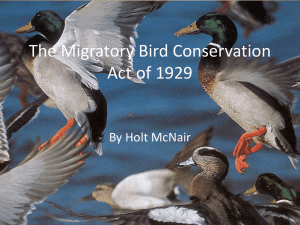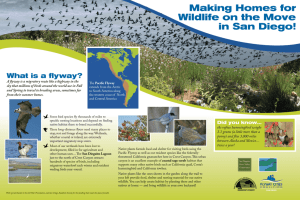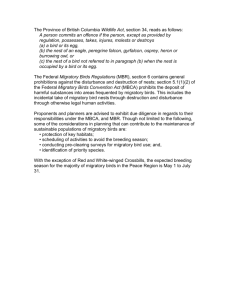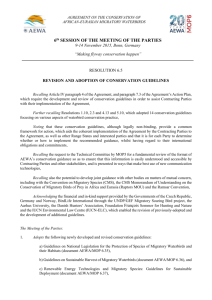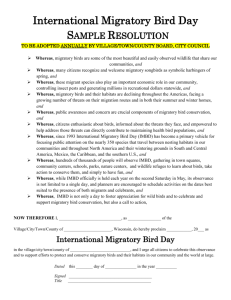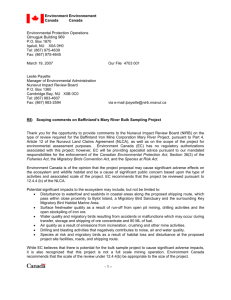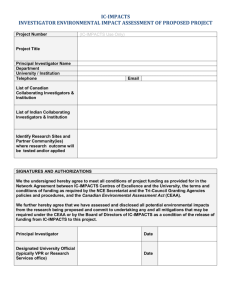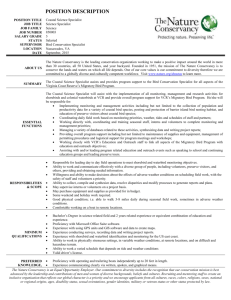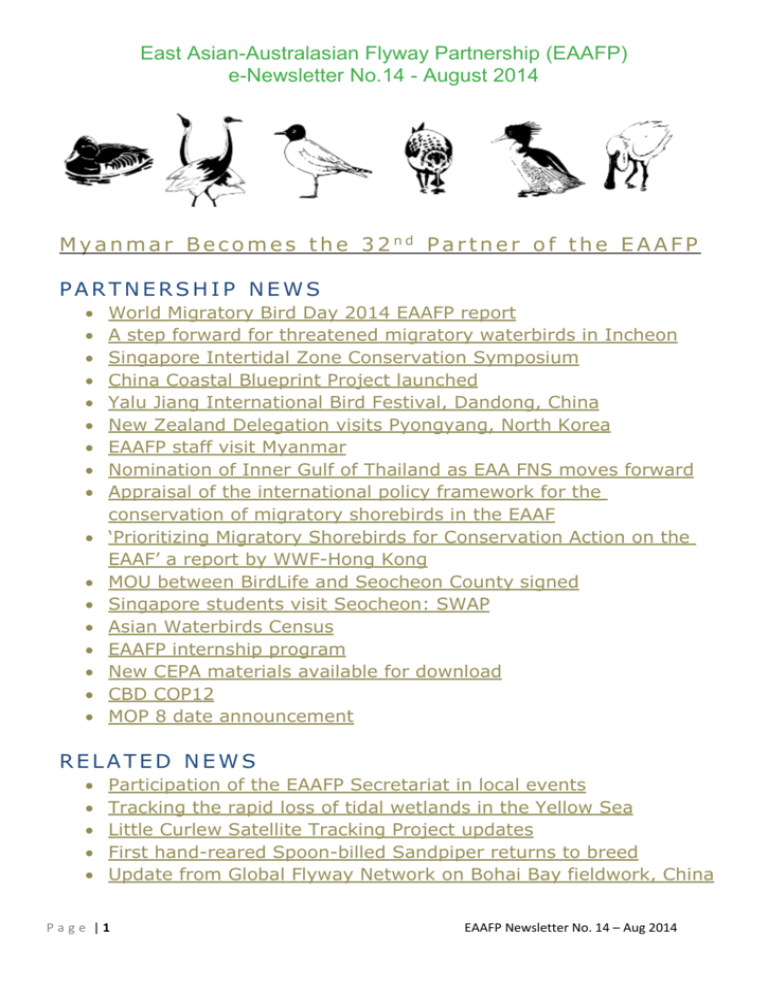
East Asian-Australasian Flyway Partnership (EAAFP)
e-Newsletter No.14 - August 2014
Myanmar Becomes the 32nd Partner of the EAAFP
PARTNERSHIP NEWS
World Migratory Bird Day 2014 EAAFP report
A step forward for threatened migratory waterbirds in Incheon
Singapore Intertidal Zone Conservation Symposium
China Coastal Blueprint Project launched
Yalu Jiang International Bird Festival, Dandong, China
New Zealand Delegation visits Pyongyang, North Korea
EAAFP staff visit Myanmar
Nomination of Inner Gulf of Thailand as EAA FNS moves forward
Appraisal of the international policy framework for the
conservation of migratory shorebirds in the EAAF
‘Prioritizing Migratory Shorebirds for Conservation Action on the
EAAF’ a report by WWF-Hong Kong
MOU between BirdLife and Seocheon County signed
Singapore students visit Seocheon: SWAP
Asian Waterbirds Census
EAAFP internship program
New CEPA materials available for download
CBD COP12
MOP 8 date announcement
RELATED NEWS
Participation of the EAAFP Secretariat in local events
Tracking the rapid loss of tidal wetlands in the Yellow Sea
Little Curlew Satellite Tracking Project updates
First hand-reared Spoon-billed Sandpiper returns to breed
Update from Global Flyway Network on Bohai Bay fieldwork, China
Page |1
EAAFP Newsletter No. 14 – Aug 2014
Myanmar wetland to be protected by the country’s first ecotourism initiative
China, Russia to monitor migratory birds
Registration open for 2014 Taiwan Birdathon
NATIONAL NEWS
Chinese News
Korean News
Published by EAAFP Secretariat
Photo Credits:
Prioritizing Migratory Shorebirds for Conservation Action on the EAAF (P12) ©WWF-Hong Kong
If not mentioned: ©EAAFP
The EAAFP Secretariat encourages Partners to voluntarily produce translated versions of the EAAFP newsletter
so that EAAFP activities and issues can be widely disseminated to a broader audience. This helps raise
awareness of EAAFP at national level that can foster national partnerships to conserve migratory waterbirds,
their habitats and the livelihood of people dependent upon them.
The EAAFP Secretariat welcomes any feedback on the EAAFP newsletter.
For further information and contact:
EAAFP Secretariat
3F Bon-dong G-Tower,
175 Art center-daero (24-4 Songdo-dong),
Yeonsu-gu, Incheon 406-840,
The Republic of Korea
Tel: +82 32 458 6504
Fax: +82 32 458 6508
Email: secretariat@eaaflyway.net
Website: www.eaaflyway.net
Facebook: www.facebook.com/eaafp
Twitter: www.twitter.com/EAAFP
Weibo: weibo.com/u/5038435405
Flickr: www.flickr.com/eaafp
YouTube: www.youtube.com/eaafps
All rights reserved
Page |2
EAAFP Newsletter No. 14 – Aug 2014
Myanmar Becomes the 32nd Partner of the EAAFP
On July 27th, the Government of the Republic of the Union of
Myanmar became the 32nd Partner of EAAFP with enthusiastic and
unanimous support from all Partners. Despite not being a formal Partner,
Myanmar has been active in supporting EAAFP and EAAFP activities for
many years.
The country is critically important for a variety of migratory waterbirds. The coastlines along the Bay of Bengal
and the Andaman Sea support extensive inter-tidal mudflats and the Gulf of Mottama, nominated as an EAAFP
Flyway Site, is of global significance for Spoon-billed Sandpipers (SBS) as it is one of the few sites supporting a
substantial proportion of the total population of this Critically Endangered species during the non-breeding
season. The EAAFP SBS Task Force works with local authorities, NGOs and communities in the area to undertake
surveys and reduce the threats of indiscriminate shorebird trapping. Historically, Myanmar has supported
important populations of another Critically Endangered species, Baer’s Pochard. More surveys and monitoring are
required to assess the status of this and other waterbird species in the country.
EAAFP SBS TF members surveying at the gulf of
Bird tracks in the mud © Christoph Zöckler
Martaban © Christoph Zöckler
Five sites – Gulf of Mottama, Indawgyi Lake, Moeyungyi Wetland, Inlay Lake and Meinmahla Island are
nominated to join the EAAFP Flyway Site Network. EAAFP looks forward to cooperating with the Government of
Myanmar to strengthen national partnerships – several national and international conservation NGOs are active in
Myanmar and support ongoing survey, monitoring and conservation efforts, including with other EAAFP Partners.
Page |3
EAAFP Newsletter No. 14 – Aug 2014
Partnership News
World Migratory Bird Day 2014 EAAFP report
With the theme ‘Destination Flyways – Migratory Birds and Tourism,’ World Migratory Bird Day (WMBD) 2014
highlighted the links between migratory bird conservation, local community development and nature-based
tourism around the world. This year’s event on 10-11 May was the most successful ever, with over 400 events
celebrated in 90 countries.
WMBD is organised by the Convention on the Conservation of Migratory Species of Wild Animals (CMS) and
the Agreement on the Conservation of African-Eurasian Migratory Waterbirds (AEWA). The theme of this year’s
WMBD, ‘Destination Flyways,’ was a project led by the UN World Tourism Organization (UNWTO). The project
aims to develop sustainable tourism at destinations along the world’s major migratory bird routes, with the initial
project phase focusing on eight key sites for migratory birds in Africa, Asia and Europe. Two of the Destination
Flyways Project sites Seocheon tidal flats (South Korea) and Chongming Dongtan Reserve (China) are in the East
Asian-Australasian Flyway (EAAF).
This year, EAAFP developed 12 different language versions of posters and 3 kinds of flyers (Thank you
volunteers for the translation!) to raise awareness of migratory birds. Also, in order to give a strong message to
general citizens, we made WMBD 2014 Trailer in English and Korean. We had a great time and great success in
the flyway as ten events were registered.
Report map at the EAAFP website
WMBD poster in Bengali
The stories below are a selection of events from around the EAAF. (With photos: http://www.eaaflyway.net/ouractivities/wmbd/background/wmbd-2014-report/)
South Korea
Over 200 people gathered on May 9th at the G-Tower in Songdo, Incheon, South Korea, where the EAAFP
Secretariat is based. The event marked the official start of celebrations for WMBD 2014 flyway wide. Present were
high level executives of multilateral organisations, Incheon government delegates and representatives from the
South Korean Ministry of Environment, as well as students from local schools.
Page |4
EAAFP Newsletter No. 14 – Aug 2014
Spike Millington, Chief Executive of EAAFP, addressed the audience with an inspiring talk about how migratory
shorebirds undertake their epic journeys and how they can play a role in helping local economies through
nature-based tourism.
A WMBD birdwatching event was held on the second day with around 100 people attending. Blessed with
glorious sunshine, local families with children of all ages were introduced to local birdlife and learned about
migration.
The day started with a lively introduction from Spike and Minseon from EAAFP Secretariat, which had the room
up and flapping to experience what it must be like to be a migrating bird, flying long distances. This was
followed by an education session on migratory birds and the importance of the local wetlands.
In small groups we visited Namdong Reservoir to see one hundred Black-faced Spoonbills breeding. Looking
across to their island we saw a number of young spoonbills, already stumbling out of the nests alongside the
fluffy grey chicks of the gulls they share the island with. At Gojan tidal flats despite a relatively low high tide we
admired feeding and resting Mongolian Plovers, Grey Plovers, Red-necked Stints, Whimbrels and Saunders’s Gulls.
After a picnic lunch, children and adults were drawing the birds they had seen in the morning, cutting them out
and placing them on banners depicting their different habitats.
There was another WMBD 2014 event supported by EAAFP in the Ganghwa area of Incheon. About 20
participants, including photographers and students enjoyed a photo competition, watched a movie about
migratory birds, and listened to short talks about the importance of the Ganghwa area as a globally important
breeding and feeding area for migratory shorebirds.
Australia
Newport Community Choir sang for WMBD 2014
On May 11, Newport Community Choir celebrated WMBD 2014 by honoring the work of the local Council
(Hobsons Bay) and the Friends of Newport Lakes, a volunteer group that assisted with the planting, weeding and
maintaining of a beautiful urban re-vegetated site. They decided to single out the work of a Friends Group who
were planting on WMBD events and treated them to a “Flash Mob.” The look on the faces of the Newport Lakes
Friends Group when the choir appeared with their banner over the crest of the hill, singing about the flight of the
Eastern Curlew, was a sight to behold. Newport Lakes is now a bush habitat in the inner west of Melbourne – a
place for birds and humans!
Bangladesh
In Bangladesh, many activities were organised to celebrate WMBD
Bangladesh celebrated WMBD 2014 in different ways. First, Bangladesh Forest Department successfully marked
the WMBD by conducting a seminar. The chief guest was Mr. Anwar Hossain Monju, Honorable Minister from the
Ministry of Environment and Forest. Also, On May 14, Bangladesh Spoon-billed Sandpiper Conservation Project
team celebrated WMBD by conducting educational activities on Sonadia Island, Cox’s Bazar. Multiple events, such
as a quiz and art competition helped the participants to learn about the shorebirds of the EAAF, with special
focus on the Critically Endangered Spoon-billed Sandpiper.
Another event in Bangladesh was celebrated by the Department of Zoology, Jagannath University, Dhaka.
‘WMBD 2014 festival’ was held at the University campus in association with the Nature Study & Conservation
Club of the university, Prokriti O Jibon Foundation, Wildlife Rescue Centre of Jahangirnagar University, Bangladesh
Bird Club, Asian Wetland Conservation Fund, and Beyond Adventure & Tourism. The program started with
Page |5
EAAFP Newsletter No. 14 – Aug 2014
documentaries on migratory birds and a rally. During this program, several competitions were arranged that
included a drawing competition for primary school students, extempore speech competition, migratory bird
identification competition and quiz. Certificates were awarded to the winners at the end of the festival. A drama
was also staged with a message on Conservation of Migratory Birds. Several nature-related organisations put up
stalls showing their migratory bird related activities. There was also a photography exhibition. Channel I was the
media partner for the festival and GreenMagzs.info covered the event the online.
Indonesia
Birdwatching in Indonesia to mark World Migratory Bird Day
Bioers Unsri Wildlife Photographers group organised a two-day event to celebrate WMBD 2014. They held a
bird watching event to see migratory birds at Tanjung Putus of Sriwijaya University, Ogan Ilir, South Sumatera,
Indonesia. For more information email aditya_yulistio@yahoo.com.
Singapore
Sungei Buloh Wetland Reserve – Singapore invited public visitors to a World Migratory Bird Day Celebration
On May 10- 11th, Sungei Buloh Wetland Reserve (SBWR) organised their now annual WMBD event. The
participants were given the opportunity to learn from talks about SBWR, Sungei Buloh, shorebird conservation
programs, and the EAAFP. Mr. David Li, Conservation Officer and project leader for SBWR’s shorebird
conservation program, gave public presentations. They also had a guided walk for visitors on the trail of the
migratory birds, a poster exhibition, and activities like making bird mobiles, wader colouring, making kingfisher
and heron masks, and video screening on migratory birds.
Japan
Organisations in Japan celebrated the World Migratory Bird Day
On May 1, the WMBD 2014 event at the Yatsuhigata Nature Observation Centre was launched in Japan. The
main event was the photography exhibition entitled ‘Borneo – paradise for shorebirds in wintering season’ in
collaboration with Urban Nature Management Services (UMS). The wonderful pictures were taken by Mr. Eugene
Cheah, from Borneo’s local community. UMS has also had a special bird watching tour for the WMBD, as a part
of guided tours held on every Saturday and Sunday in Yatsuhigata.
Another bird watching activity in Japan was conducted by Hamatonbetsu Sightseeing Association on April 26.
At the Hamatombetsu Lake Kutcharo Waterfowl Observatory, the Hamatonbetsu Bird Fair 2014 hosted a bird
watching camp, including educational activities (drawing and painting), symposium and forum. Many local
residents participated in the different kinds of conservation activities. There was also a quiz show for guessing the
arrival date of migratory birds at the place. The participants enjoyed the engaging activities and the event was a
great opportunity for local people to learn about migratory birds.
Yonago Waterbirds Sanctuary also arranged the WMBD event titled as ‘Let’s take ducks’ footprints.’ Participants
explored parts of the bird reserve that are usually prohibited to the public, and looked for the footprints of ducks
and other creatures to turn them into plaster casts. The weather was beautiful and after finding the footprints
and other field marks of many different bird species (ducks, shorebirds, egrets and others) participants brought
the plaster casts back to the Nature Center and checked which species they have found.
Page |6
EAAFP Newsletter No. 14 – Aug 2014
A step forward for threatened migratory waterbirds in Incheon, Korea
Incheon and Gyeonggi tidal flats are important for a great number of migratory bird species, which are now
threatened by rapid urban development and reclamation of coastal areas. The EAAFP Secretariat has been
holding meetings to take proactive measure to halt the unsustainable development in this area with key
stakeholders including central and local governmental agencies, NGOs and experts. As a side event of the World
Wetland Day Celebration in Korea on 10 July, a workshop was convened with key Incheon stakeholders for
information sharing on current threats to birds and their habitats and suggestions to develop action plans. The
target species are Black-faced Spoonbill, Saunders's Gull, Chinese Egret and other shorebirds that depend on
mudflats in Incheon, their breeding grounds and stopover sites.
Incheon-Gyeonggi Ecoregion is a part of the Yellow Sea and supports a large number of migratory waterbirds
including Endangered species such as Black-faced Spoonbill. The breeding colonies of Black-faced Spoonbill in
Incheon and Gyeonggi areas represent a large proportion of the population in the East Asian-Australasian Flyway.
Black-faced Spoonbills breed on islets off the west coast of Korean peninsula and Liaoning province in mainland
China. Since 2006, there has been a breeding colony of Black-faced Spoonbill, an artificial island at Namdong
Reservoir in Incheon city, currently consisting of a hundred pairs. Black-faced Spoonbill’s breeding was very
successful this year because this summer was less rainy than usual. However, the mudflats in Songdo are
disappearing due to urban development. Many international and local bird experts have been concerned that the
birds will abandon this colony because there is no feeding area left nearby.
During the workshop, Dr. Lee Kisup, from the Korea Waterbird Network, said that according to satellite tracking,
Black-faced Spoonbills that breed at Namdong reservoir started to use Shiheung mudflat, south from Songdo, in
preference to Songdo mudflats. If all of these birds move to Shiheung mudflats to feed and to rest, they are likely
to abandon Namdong reservoir to start a new colony near Shiheung city. If so, Incheon could lose a precious
natural heritage – the Black-faced Spoonbill’s breeding site at Namdong Reservoir.
Dr. Hwang Bo-Yeon from National Park Service commented
on Saunders’s Gull breeding grounds in Songdo. "Eighty pairs
of Saunders’s Gull were breeding in Songdo this year. However,
they were only seen in Zone 6. They also used to nest in Zones
8 and 9. As they tend to nest on the ground in Common
Seepweed
Suaeda
glauca
saltmarsh
habitats,
building
constructions in Zones 8 and 9 have caused all breeding pairs
of Saunders’s Gull to abandon these zones. If there is no
urgent action taken soon in Zone 6 to save the Saunders’s Gull,
Bird numbers sharply declined because of
we will not have any Saunders’s Gull breeding in Songdo next
reclamation © Kyeongin Ilbo
year."
This initiative will help establish a sub Task Force, a part of the Yellow Sea Task Force, with key stakeholders to
develop action plans and take proactive actions against destroying habitats and biodiversity, and conserving
precious natural heritage, migratory waterbirds and mudflats.
The next meeting is scheduled on 16th September to examine urban development plans in Incheon wetlands.
For further details, please contact Minseon Kim, EAAFP Program Officer.
Page |7
EAAFP Newsletter No. 14 – Aug 2014
Singapore Intertidal Zone Conservation Symposium
A two-day Symposium on Intertidal Conservation in
Southeast Asia was held at Sungei Buloh Wetland Reserve
(SBWR) in Singapore on 12-13 June 2014, co-hosted by
BirdLife International, the National Parks Board, the
National University of Singapore’s Asia Pacific Centre for
Environmental Law (APCEL/NUS), and the Nature Society
of Singapore. The Symposium aimed to raise awareness
Group photo of the symposium ©Jerome Kok
amongst policy- and decision-makers on the need for
conservation of intertidal areas along the East Asian-
Australasian Flyway (EAAF), particularly in a changing climate. The Symposium gathered 87 academics, site
managers, and mid-level policy-/decision-makers working in the field of coastal management from across
Southeast Asia.
Speakers from seven countries presented to participants from 11 countries and territories across the region and
beyond: Australia, Bangladesh, Cambodia, Hong Kong SAR, Indonesia, Malaysia, South Korea, Singapore,
Philippines, Thailand, and Vietnam. Spike Millington, EAAFP Chief Executive, participated in the Symposium and
gave an opening presentation on the state of the Flyway and the role of the EAAFP. He also facilitated two
breakout sessions on ‘Land Use’ and on ‘Regional Policy and Cooperation.’
Intertidal areas, such as mudflats are important ecosystems. They usually support a large population of wildlife,
and are key habitats that allow tens of millions of migratory shorebirds to migrate between breeding and nonbreeding sites. The SBWR, for instance, serves as a stop-over for migratory birds to feed and refuel. To emphasize
the importance of the flyway and urgent need to conserve intertidal areas, following IUCN Resolution 28, it was
agreed to hold a series of regional workshops on conservation of the intertidal zone in the EAAF. This event was
designed to cover South-East Asia, notably the ASEAN countries and including Bangladesh. It was the first
international event to be hosted by Sungei Buloh (a Flyway Network Site) following recent expansion of facilities.
China Coastal Blueprint Project launched
The China Coastal Wetland Blueprint Project, jointly implemented by the State Forestry Administration (SFA),
the Paulson Institute (PI) and the Institute of Geographic Sciences and Natural Resources Research (IGSNRR) of
the Academy of Sciences, held its Inception Workshop on 17-18 April 2014 in Beijing.
The Blueprint project aims to assess the current status, trend and threats of coastal wetlands in China, conduct
case studies and best practices on wetland conservation in USA and China, and define the strategy, policy
framework and priority actions on coastal wetlands protection and management in China. The ultimate goal is to
identify feasible policy options for the decision-makers, provide effective management tools for competent
government agencies, and promote the coastal wetlands protection and management at policy and practice
levels in China. Chief Executive Spike Millington is on the Steering Committee of the project and PI and gave a
presentation on EAAFP and participated in Task Force meetings. Prof. Lei Guangchun, EAAFP Technical Focal Point
for China, heads up the Task Force. One Task Force team will focus on migratory waterbirds and identify key sites
for nomination to the EAAFP Flyway Site Network. Another will undertake a scenario analysis, based on businessas-usual, planned and optimal scenarios for coastal wetland development. It will also build on China’s recent
National Wetland Inventory, coordinated by SFA’s Wetland Centre.
Page |8
EAAFP Newsletter No. 14 – Aug 2014
Yalu Jiang International Bird Festival, Dandong, China
The mouth of the Yalu River (Yalu Jiang) in Liaoning Province of Northeast China forms the border between
China and North Korea and is probably the most important remaining inter-tidal mudflat in the Yellow Sea
supporting tens of thousands of staging shorebirds, particularly Bar-tailed Godwit and Great Knot. Part of the
area is a National Nature Reserve, although some of this area has recently been de-gazetted for port
development. It is an EAAFP Flyway Network Site, and has a sister site relationship with Pukorokoro Miranda
Naturalist Trust (PMNT) in New Zealand (NZ) and a history of cooperation with the Trust in monitoring shorebird
status and trends. The "Yalu Jiang International Bird Festival" took place on May 3-5th in Dandong. EAAFP took
part in the festival to share ideas on how to conserve intertidal areas in Yalu Jiang and was represented by Chief
Executive Spike Millington and representatives from EAAFP Partners, such as the NZ Government, PMNT and
Wetlands International China.
The
festival
was
supported
by
the
Dandong
government. Nearly 500 participants attended this festival
including high level officials, Secretary General, Mayor and
Vice-Mayor of Dandong, representatives of the Ministry of
Environmental
Protection
and
State
Forestry
Administration, Government of China, the NZ Ambassador
to China, the Department of Conservation of NZ, PMNT,
and staff from the Yalu Jiang National Nature Reserve.
There was also a special event to celebrate 10 years’
cooperation between Yalu Jiang and PMNT in waterbird
monitoring and publication of results. Joint surveys were
Yalu Jiang International Bird Festival, Liaoning Province,
also held during and after the Festival.
China ©东北新闻网
During this trip, EAAFP delegates had a discussion with Mayor and Vice-Mayor of Dandong, as well as a
discussion with NZ delegations.
New Zealand Delegation visits Pyongyang, North Korea
Keith Woodley Manager, Pukorokoro Miranda Shorebird Centre
A substantial gap in our knowledge of shorebirds around the Yellow Sea could be closed over the next few
years following the visit of a New Zealand delegation to Pyongyang, North Korea in May. The delegation from
Pukorokoro Miranda Naturalists’ Trust (PMNT) and the Department of Conservation met with officials of the
Nature Conservation Union of Korea (NCUK). A five-year agreement on exchange and cooperation between NCUK
and PMNT was signed. A draft work program identifies four sites to be progressively surveyed and documented
over four years, commencing in April 2015, followed by publication of data. As part of the project it is hoped
there will be an opportunity to conduct simultaneous surveys on either side of the North Korea-China border.
Since 2004, PMNT has worked in partnership with Yalu Jiang National Nature Reserve in China to document the
importance of that site for shorebirds in the East Asian-Australasian Flyway. Observations during these surveys
revealed substantial flocks of birds crossing over into the North Korea. Progressing with this project is however,
contingent on securing funding, and PMNT is currently investigating possible sources of support.
Page |9
EAAFP Newsletter No. 14 – Aug 2014
EAAFP staff visit Myanmar
On June 14, Spike Millington, Chief Executive, and
Minseon Kim, Program Officer, headed to Myanmar to
support and follow up Myanmar’s application to join
EAAFP and its nomination of Flyway Network Sites.
Meetings were held with Director Win Naing Thaw and
Mr. Pyi Soe Aung of the Nature and Wildlife
Conservation Division of the Ministry of Environmental
Conservation and Forestry to prepare the application
documents.
The
Director
General
of
the
Forest
Department, Dr. Nyi Nyi Kyaw then signed the formal
Meeting with NGO, Yangon, Myanmar ©BANCA
application.
Five EAAFP Flyway Network Sites were identified and proposed, with boundaries and criteria. These are the Gulf
of Mottama, a critical site for Spoon-billed Sandpipers and other shorebirds, Indawgyi Lake, Moeyungyi Wetland,
Inlay Lake and Meinmahla Island. Spike and Minseon also held meetings and discussions with conservation NGOs
in Yangon, including Biodiversity and Nature Conservation Association (BANCA), Wildlife Conservation Society (an
EAAFP Partner), Bird & Nature Society, to promote cooperation. EAAFP’s visit to Myanmar strengthened the
relationship with Myanmar government and NGOs.
Nomination of Inner Gulf of Thailand as EAA Flyway Network Site moves forward
The Inner Gulf of Thailand has a 195 km-long section of the coastal zone from Laem Phak Bia in the west to
Chonburi in the east and includes an estimated 23,500 ha of intertidal mudflats, extending over 2 km from the
shoreline at low tide in places. Four major rivers, Mae Klong, Tha Chin, Chao Phraya and Bang Pakong, discharge
into the Gulf of Thailand along this stretch of coastline, creating extensive areas of intertidal habitats. This site is
one of the most important areas for migratory waterbirds, especially Spoon-billed Sandpiper, in the East AsianAustralasian Flyway.
In June 2014, Minseon Kim, Program Officer of the EAAFP,
travelled to Bangkok to meet with Government, NGO and other
Thai stakeholder representatives about EAAFP Flyway Network
Site (FNS) nomination. Minseon, Nirawan and her colleagues
from the Thai Government (Office of Natural Resources and
Environmental Policy and Planning, ONEP), Wicha and Jintana of
Thai Wetland Foundation, Philip Round of Mahidol University
and Bird Conservation Society of Thailand (BCST) went on a field
trip to the most important sites for the Critically Endangered
Spoon-billed Sandpiper and other migratory shorebirds. Nine
Bird Center, Khok Kham Shorebird Site, Thailand
sites have been identified including Khok Kham, Pak Thale,
Lim Pak Bia and Bang Pu as globally important areas for wintering shorebirds. All Thai stakeholders including
ONEP agreed on the need of international recognition through FNS designation and the importance of twinning
sites across countries that share waterbird species and face similar difficulties to conserve their habitats. They also
discussed improved site conservation and management after site nomination. Together with the Thai Wetland
P a g e | 10
EAAFP Newsletter No. 14 – Aug 2014
Technical Working Group, ONEP will lead and follow up with the necessary procedures, information gathering and
site review, for FNS nomination in the coming months. These nine sites will be nominated as FNS. EAAFP and
Thailand will start to develop a Thai website under the EAAFP website for information sharing and capacity
building. Thailand will appoint a contact point from ONEP for Thai website development and maintenance.
Minseon also participated in the Ramsar Workshop on “Developing Management Criteria and a Management
Effectiveness Process” during her trip in Bangkok. The workshop plans to produce a document “Guidance and
Best Practices for the Management of Ramsar Sites” and to propose an internationally acceptable process for
monitoring the management of Ramsar Sites. The output will contribute to the drafting of a guideline for
effectiveness of management of Ramsar Sites and other wetlands.
Appraisal of the international policy framework for the conservation of migratory
shorebirds in the East Asian-Australasian Flyway (EAAF)
Eduardo Gallo-Cajiao, EAAFP intern
After some months in Australia’s southeast from January through
April, six weeks in South Korea from May, and two weeks in China in
late June, here is a bit of a story about what I have been up to as part
of my internship project on policy analysis.
Through my internship at the EAAFP, in the lead up to my PhD at
the University of Queensland, I have undertaken an initial step towards
appraising policy effectiveness for migratory shorebirds. International
policies for conservation of this group of birds have been emerging
Eduardo Gallo-Cajiao, EAAFP intern (right)
since the 1970s in our flyway. However, little is actually known about
policy effectiveness. This internship project is primarily focused, as a first stage of policy evaluation, on a
comprehensive survey of the international policy framework for shorebird conservation in the EAAF and its
domestic implementation in four countries (i.e., Australia, China, Japan, and South Korea).
Working on policy analysis has taken me around the flyway. My “field work” has involved talking to people and
reviewing policy documents. This has been a very exciting and rewarding task, as I have been visiting people in
Canberra, Sydney, Seoul, Jeju Island, Nami Island, Seocheon, Incheon, Beijing, and Tianjin. Part of my methods
include key stakeholder interviews, which are an approach to have quick access to important and complex
information, gain knowledge of policy processes and development, identify variables shaping policy, establish
roles of different actors, and obtain expert opinions on policy performance.
My target stakeholders comprise senior officials from research institutions, NGOs, and national government
agencies from Australia, South Korea, and China. So far I have completed over 30 interviews; most of them in
person, but a few others have been held via Skype and over the phone. Most of interviews have been conducted
in English the rest in other languages with the help of interpreters. These interviews have taken me to some of
the top research institutions in the flyway, key government agencies, important NGOs, as well as allowing me to
meet very interesting and influential people at national and local levels. As I must abide by best standards of
ethics when conducting this type of research, no individual names or institutions can be disclosed, though I am
enormously grateful to everyone involved. Now it is finally time to go back to Brisbane, where I will be based at
the University of Queensland writing the final report. The technical document is expected to be available by
September. Stay tuned.
P a g e | 11
EAAFP Newsletter No. 14 – Aug 2014
Acknowledgements: This project has been possible through funding provided by the Australian Government’s
Department of the Environment, the University of Queensland, and the EAAFP. Logistical support has been
provided by WWF’s regional offices in Australia, China, and Japan. I am very thankful to staff in all those offices.
Additionally, I would like to extend a huge thank you to the EAAFP Secretariat crew based in Songdo, who were
of great support during my time in South Korea.
In the hunt for shorebird hunting: “Take,” which includes hunting, accidental catch or egg collection, is one of the
many threats faced by migratory shorebirds in the EAAF. This threat is difficult to evaluate though, because it may
happen at very specific sites and may fluctuate over time. Therefore, information from stakeholders from across
the Asia-Pacific region can help to build a better understanding of this issue to support conservation plans. A
short and easy survey is available online. Your contribution would be highly appreciated if you have any
information about shorebird hunting in our flyway.
‘Prioritizing Migratory Shorebirds for Conservation Action on the EAAF' a report by WWFHong Kong
Mr. Bena Smith (WWF-Hong Kong)
The report is an initiative for regional prioritization of the status of shorebirds using
the EAAF, and is an objective assessment of the conservation status of EAAF populations
using the latest available data on population size, trends, and distribution, to determine
which populations are most likely to reach or approach extinction if measures are not
taken. It is designed to stimulate and enable stakeholders in the EAAF to take actions
that will effectively minimize further decline and loss of migratory shorebird populations
in the flyway.
Many shorebird enthusiasts in the flyway, including members of the Shorebird Working Group, contributed to
the report through the donation of personal records, data checking and reviewing drafts. <Download>
For further information please contact Mr. Bena Smith, Conservation Manager - Regional Wetlands.
News from Partners
MOU between BirdLife and Seocheon County signed
Ms. Becky Rush (BirdLife International, Singapore)
Rio Tinto, through the Rio Tinto-BirdLife International Partnership Programme, is providing funding until the
end of 2015 for a pilot project on migratory bird conservation within the East Asian-Australasian Flyway (EAAF) to
help achieve their commitment to Net Positive Impact on biodiversity, and to help safeguard seven species of
shorebirds found at Rio Tinto-managed solar salt operations in Western Australia. After exploring a number of
different options using a novel framework developed by BirdLife, the Geum Estuary in South Korea was identified
as a project site due to its importance for migratory birds, the positive political environment and the conservation
opportunities at the site (including through the development of ecotourism). Co-funding has also been secured.
P a g e | 12
EAAFP Newsletter No. 14 – Aug 2014
An MOU was signed between BirdLife and the local government (Seocheon County) in April 2014, and a workplan
has been drafted.
In May 2014, Cristi Nozawa and Becky Rush of BirdLife International - Asia Division travelled to South Korea.
During this trip, a contract was signed with Kwanmok Kim and Young-Min Moon, who will act as joint Project
Coordinators in Korea. Cristi and Becky, along with Spike Millington and Minseon Kim of the EAAFP, also met
with the Seocheon County Government, the National Institute of Ecology and the National Institute of Marine
Resources, all of whom expressed support for the project and interest in being involved in the delivery of the
workplan. A representative of the United Nations World Tourism Organization (UNWTO) was also present, as the
Geum Estuary is one of eight sites in their new ’Destination Flyways’ project aimed at conserving migratory birds
through tourism. To top it off, thanks to Spike’s keen eyes, they even saw a Critically Endangered Spoon-billed
Sandpiper during the trip to Yubu-do Tidal Flat in the Geum Estuary.
Figure 1 The location of Geum Estuary and the Yubu-do Tidal Flat. The red polygon indicates the boundary of the IBA,
the yellow polygons indicate the Ramsar site boundary, and the purple and blue polygons are the two EAAF Flyway
Network Site boundaries (Yubu-do Tidal Flat and Geum River Estuary respectively). The pale purple line indicates the
county boundary, with Seocheon County to the north and Gunsan County to the south. Inset is the location of Geum
Estuary in South Korea ©BirdLife International (all the photos in this article)
Figure 2 Trip participants outside the Migratory Bird
Figure 3 Trip participants headed to Yubu-do Tidal Flat
Centre in Seocheon County
and had the luck to see a Critically Endangered Spoonbilled Sandpiper and many other migratory waterbirds
P a g e | 13
EAAFP Newsletter No. 14 – Aug 2014
River Valley High School students from Singapore visit Seocheon County, South Korea as part of
Sister Wetland Affiliations Programme
Mr. Mohamad Azlin (National Parks Board, Singapore)
As part of the Sister Wetland Affiliations Programme (SWAP), linking Sungei Buloh Wetland Reserve (SBWR) and
Seocheon County, a group of 22 students and three
teachers from River Valley High School embarked on a
one-week exchange program to the Republic of Korea.
River Valley High School has been working on projects in
SBWR on topics related to wetlands conservation and
migratory birds since 2010 and in conjunction to the
SWAP, they presented their finding to their sister school,
Seocheon Girls’ High School.
With visits to highlight Seocheon’s natural biodiversity
and their traditional heritage, the students were able to
Group photo of the SWAP, Seocheon, South Korea
immerse themselves in an experiential learning. One of the
©SBWR
activities was bird watching at Bongsun Reservoir and
Seocheon Tidal Flat, which is a Flyway Network Site and a Ramsar Site. There the students were able to connect
with the birds that they have seen in Singapore and notice the differences, especially in their plumage.
The SWAP has brought renewed partnership between Seocheon County and SBWR as the students from both
countries got to learn and share each other experiences and cultures. Everybody is looking forward to the next
meeting, when the Seocheon Girls’ High School students will visit Singapore.
Asian Waterbirds Census - Wetlands International News
The Asian Waterbird Census (AWC) promotes annual monitoring of internationally and nationally important
sites, including many of the East Asian-Australasian Flyway Network Sites. The AWC coordinating team has been
working hard with AWC coordinators and participants to obtain count information for the last few years, plugging
information gaps and verifying information. The latest AWC Newsletter includes an overview of the number of
counts received up to 25 June 2014. <Read More>
From the Secretariat
EAAFP internship program
If you would like the opportunity to experience life in South Korea, or visit the home of the Black-faced
Spoonbill, we are always providing opportunities for enthusiastic interns! As East Asian-Australasian Flyway (EAAF)
has 15 different languages besides English and the most challenge is language barrier, additional EAAF languages
are a plus (e.g. Korean, Chinese, Russian, Japanese, Thai and Mongolian etc.). Possible areas of work are in the
scientific, technical, administrative and information fields to assist in the accomplishment of specific tasks.
Currently we are seeking someone with good website skills and experience to work as Website Manager Intern.
Please find more information to apply at: http://www.eaaflyway.net/resources/jobs/
P a g e | 14
EAAFP Newsletter No. 14 – Aug 2014
Materials Update - New CEPA material online available for download
(1) EAAFP Banner-posters: EAAFP Banner-posters (a set of six posters, 70 x 180 cm each) are produced by the
Secretariat with financial and technical support from Partners to enhance public awareness on migratory
waterbirds and their habitat in the flyway - in Korean: http://www.eaaflyway.net/resources_rok/ (and in English:
http://www.eaaflyway.net/resources/eaafp-publications/)
(2) Stickers: Ten sticker designs (Spoon-billed Sandpiper, Nordmann’s Greenshank, Great Knot, Greater Whitefronted Goose, White-naped and Siberian Cranes, Chinese Crested Tern, Scaly-sided Merganser, Black-faced
Spoonbill, Chinese Egret and Asian Dowitcher) - http://www.eaaflyway.net/resources/eaafp-publications/
(3) Colourings (English/Korean): Colouring templates of six migratory waterbird species (White-naped Crane, Baikal
Teal, Bar-tailed Godwit, Far Eastern Curlew, Scaly-sided Merganser and Spoon-billed Sandpiper) developed for
the WMBD 2014 by the EAAFP Secretariat - http://www.eaaflyway.net/resources/eaafp-publications/
If you can translate any of these materials into other languages, please let us know: Secretariat@eaaflyway.net
(1) Banner-posters
(2) Stickers
(3) Colourings
Upcoming events
12th Meeting of the Conference of the Parties to the Convention on Biological Diversity
As a Partner of the Convention on Biological Diversity (CBD), EAAFP will participate
in the 12th meeting of the CBD in Pyeongchang, South Korea, from 6-17 October 2014.
The theme of the CBD COP12 is “Biodiversity for Sustainable Development.” The EAAFP
Secretariat is arranging a meeting for EAAFP partners as well as side-events, an
exhibition booth, CEPA fair, field excursion and signing ceremony with CBD as part of a
press conference. Details will be updated at the EAAFP CBD COP12 webpage.
EAAFP Side Events (The date and venue will be announced on 18 August 2014)
1) Addressing the Ecological Crisis for Migratory Waterbirds in Yellow Sea (Confirmed)
2) Conserving Migratory Birds: The challenge of CEPA across the diverse cultures and capacities of Flyway
Countries (To be confirmed)
EAAFP Exhibition (6-17 October)
“Sustainable Fair for Biodiversity” exhibition booths will be arranged at Exhibition Hall, Alpensia Resort. Partners
P a g e | 15
EAAFP Newsletter No. 14 – Aug 2014
can join to present their educational outreach material, such as posters, brochures, audiovisual, etc. Please submit
display proposals to Tomoko Ichikawa (Ms.), Communication Officer, by 31 August. Please include the following
information when sending your proposal: (1) Name and short description of the material, (2) Name and contact
information of exhibitor, (3) Dates you are attending at the CBD COP12.
MOP 8 date announcement
The 8th Meeting of Partners (MOP8) of the EAAFP is confirmed as 16-21 January 2015, in Kushiro, Hokkaido,
Japan (note that the end date has been changed). It will be kindly hosted by the Ministry of Environment, Japan,
and Kushiro City. Updates are at the EAAFP MOP 8 Webpage.
Related News
Participation of the EAAFP Secretariat in local events
Being located in Songdo, Incheon, South Korea, the EAAFP Secretariat has participated in several local events.
EAAFP booth at the World Environment Day Event
Firstly, on 14 June 2014, the Secretariat participated in the World Environment Day Event held in the Incheon
Environmental Cooperation. The EAAFP booth “Incheon Birds House,” showed the importance of the Incheon
coastal area and tidal flats for migratory birds. Around 400 Incheon residents of all ages visited our booth,
enjoying various educational activities. For instance, we designed a quiz to highlight the importance of protecting
migratory birds, and show the plight of the locally breeding Black-faced Spoonbill. A popular attraction was our
colouring activity for children, featuring four of our key migratory waterbirds, the Far Eastern Curlew, Black-tailed
Godwit, White-naped Crane and Critically Endangered Spoon-billed Sandpiper. Besides EAAFP, the event featured
many local environmental conservation campaigns with 30 different booths, bazar, quiz, shows and drawing
competitions.
Secondly, on 7 June, Chief Executive Spike Millington and several staffs joined the Black-faced Spoonbill
Birthday Party held by the Incheon Black-faced Spoonbill Network with around 70 participants at Namdong
Reservoir, Incheon. The aim of the party was to enhance awareness for Incheon citizens, school students and their
families of the importance of protecting Namdong reservoir and Gojan tidal flat. The party was started with an
P a g e | 16
EAAFP Newsletter No. 14 – Aug 2014
ocarina song played by a student, then followed by short lectures, bird watching, and other creative activities
such as drawing competition and a treasure hunt. During the closing ceremony, Deputy Director Jong-Ok Jang
endorsed the ‘birthday party’ as a valuable event to encourage local people and their families to learn about and
participate in environment conservation for the benefit of Black-faced Spoonbill and their habitat.
A participant drawing a Black-faced Spoonbill at the
Exhibition booth, World Wetlands Day Festival
Black-faced Spoonbill birthday party
Thirdly, on July 10-11 the Secretariat participated in the 13th World Wetlands Day Festival, supported by the
Ministry of Oceans and Fisheries (MOF) at Songdo Convensia. This year’s theme was “Wellbeing with Wetlands,”
in recognition of the important relationship between the two. Around 1000 participants attended the festival,
including members of government agencies, NGOs, conservation organisations and interested citizens. During the
Ceremony, Mr. Woo Yea Hwang, Vice Minister of the MOF gave the certificate for the designation of the Songdo
Taidal Flat as a new Ramsar site of international importance to Mr. Jeong-bok Yoo, Mayor of Incheon
Metropolitan City. Mr. Yoo mentioned that the designation would show the dedication of Incheon City against
the continuous development of the adjacent reclamation activities.
To raise awareness of the importance for the wetland for migratory birds, EAAFP organised a workshop as a
side event to share information on current threats to birds and their habitats. There were also suggestions to
develop action plans, with the participation of key Incheon stakeholders including government, NGOs. <Read
more: A step forward for threatened species of migratory waterbird in Incheon, South Korea>
EAAFP also participated in Korean Shorebird Network Workshop which aimed at sharing the knowledge on the
conservation and wise use of Korean wetlands to protect migratory birds. The meeting began with a video of
Black-faced Spoonbills and their struggle for survival on the ever decreasing intertidal mudflats. The video also
included the aquatic life of wetland residents and fishers. After that, Dr. Judit Szabo, EAAFP Science Officer talked
about the habitat loss in the Yellow Sea area and the resulting global decline of shorebirds. The next presenter
was Mr. Ju Yong-gi, bird researcher, highlighting the importance of wetland conservation in Korea. Many effective
suggestions were made by the participants.
EAAFP also had a booth with posters and educational activities, such as weighing (pretend) migratory birds,
observing tidal flat creatures, such as crabs and worms, and comparing the sand from the tidal flat surface with
the sand purified by crabs. Students were very surprised at the migration of Red-necked Stints considering how
small they are, and the distance Bar-tailed Godwits can fly non-stop. Visitors were interested in watching small
crabs and worms digging and eating in the mud in the container. An elderly lady told us about her young days at
tidal flats near Incheon, catching worms for fishing, which she said is not possible anymore because of the
reclamation. Exhibitors also exchanged ideas and information with each other.
P a g e | 17
EAAFP Newsletter No. 14 – Aug 2014
Tracking the rapid loss of tidal wetlands in the Yellow Sea
June 2014 / Authors: Nicholas J Murray, Robert S Clemens, Stuart R Phinn, Hugh P Possingham, and Richard
A Fuller / Frontiers in Ecology and the Environment
Figure 1 An example of tidal flat mapping results, showing the raw
data (a–c) and mapped tidal flats (d–f). The results reveal widespread
loss of tidal flats from 1954 (left) to 2010 (right). Satellite images (b)
and (c) show that tidal flats present in 1981 (e) were reclaimed for
agricultural and industrial land by 2010 (f). © Nick Murray
This newly published study by Nick Murray and colleagues
assesses the extent of tidal flat loss in the Yellow Sea area. The
study area is the coastal stretch from north Jiangsu province in
China, around to the coast of North Korea to Busan in South Korea. The authors analysed old maps and more
recent satellite images to assess change over a 50 year period, covering around 4000 km of coastline.
Yellow Sea tidal flats provide an estimated $30 billion in ecosystem services. They are important in stabilising
coastlines, defending against storm surges, and providing economic opportunities to human communities. The
coastal zone is home to 60 billion people. This population pressure coupled with unprecedented urban, industrial
and agricultural expansion has put the heath of the ecosystem under severe strain and there is concern for the
conservation status of the many species reliant on the tidal flats. The team digitized the detailed topographic
maps of the US Army Map Service dating back to the 1950’s as their baseline, and used the satellite imagery of
the Landsat Archive from the 1980’s and early 2000’s, estimating tides at the time of the images and using an
error matrix to assess the accuracy. Results show that the extent of tidal flats in the 1980’s was 545,000 ha, that
has shrunk to 389,000 ha in three decades, equating to a 28% net loss. The greatest extent of loss is along the
coast of China (39.8%) and South Korea (32.2%). Taking into account the 1950’s topographical maps, it is
suggested that this could equate to 65% decline in 50 years.
In discussion, the loss of tidal flats is equated to that of other ecosystems, such as tropical forests and
mangroves. It is also highlighted that the drivers for the decline in tidal flats are not unique to the Yellow Sea.
Degradation and reclamation is happening worldwide, and seems likely to intensify. Damming of rivers, trapping
sediment in reservoirs, which would otherwise continue to maintain tidal flats and river deltas, combined with
resource extraction and coastal development could contribute to sea level rises greater than the global average.
Figure 2 Examples of tidal flat conversion to alternative land uses, Landsat
Archive Imagery. (a and b) Coastal reclamation for resource ponds (salt
ponds) and industrial land, Bohai Bay, China. (c and d) Reclamation for
urban and industrial land, Incheon, South Korea © Nick Murray
The Yellow sea coastal region is of utmost importance for many
migratory shorebird species, which are solely dependent on the
food resources supported by the tidal flats for their survival. The
Great Knot and Far Eastern Curlew, for example, have been
deemed globally threatened by the IUCN.
Original article: http://www.esajournals.org/doi/abs/10.1890/130260
P a g e | 18
EAAFP Newsletter No. 14 – Aug 2014
Little Curlew Satellite Tracking Project updates
Ms. Inka Veltheim (Australasian Wader Studies Group)
Although studies on migratory birds have been increasing over the
years, there has been almost no research undertaken on the Little
Curlew. To record the unknown migratory paths and breeding areas of
Little Curlew, the Australasian Wader Studies Group (AWSG) attached
satellite transmitters on five individual Little Curlews before their
migration. Three of these left Australia on migration, starting with the
first bird in late April, and the other two birds departed by May 13. In
the migration toward north, the first bird, after stopping over at several
Final tracks of Little Curlews ©AWSG
sites such the Philippines, finally arrived in its breeding ground around
Siberia, Russia, a month after it left Australia. The second Little Curlew,
after stopping over in the Putian area and Rudong, China, landed in Hulun Lake of Inner Mongolia, where it
appears to have stopped its migration. The last bird, after stopping over at the agricultural area of Philippine
Island Province of Palawan, the coast of China, then Rudong, Jiangsu and an inland lake near Yishui, Shandong,
China, then moved to an area near Liangungang, Jiangsu, China. In the last report on 29 July, the first bird
already has started southward migration. <More information>
First hand-reared Spoon-billed Sandpiper returns to breed
25 June 2014 / Photo & report: Mark Simpson (Wildfowl & Wetlands Trust) / Saving the Spoon-billed
Sandpiper
The first hand-reared Spoon-billed Sandpiper has returned to
breed in Chukotka, Russia, where it was hatched two years ago.
The Spoon-billed Sandpiper is unique in the animal kingdom for
being born with a spoon-shaped beak. Numbers have declined by a
quarter year on year and it is likely that fewer than 100 pairs remain
in the wild.
WWT aviculturist Roland Digby has reared 24 Spoon-billed
Sandpipers over the last two summers on their breeding grounds in
north eastern Russia, giving them a head start to ensure they
survived their crucial first days of life. Once released, the birds
migrated 5,000 miles to south Asia, facing exhaustion, starvation
and illegal hunting along the way. There has been a two-year wait
to see if any will survive to return to breed. <Read more> <Related
post: Courtship in Chukotka and Slimbridge> <Visit to read about
Spoon-billed Sandpiper Task Force conservation work with EAAFP>
<Relevant video: Can we save the
Spoon-billed Sandpiper?>
P a g e | 19
EAAFP Newsletter No. 14 – Aug 2014
Update from Global Flyway Network on Bohai Bay field work, China
Report by Global Flyway Network
The second update of 2014, featuring the fabulous photography skills of
Adrian Boyle and Matt Slaymaker, can be found <here>. You can also see
their yearly reports and further/latest updates at their website.
Flying Knot © Global Flyway Network
Myanmar wetland to be protected by the country’s first eco-tourism initiative
18 June 2014 / Wildlife Extra
A bird-haven in northern Myanmar is to benefit from a
government-led, community-based, eco-tourism initiative that will
ensure visitors to the area help protect, not damage, its unique
habitat. One of the biggest inland stretches of water in Southeast
Asia, Indawgyi Lake, is a mecca for nearly a hundred different species
of migratory birds that flock there in their thousands to spend the
season, from as far away as Siberia. These include several species of
global conservation concern such as the Slender-billed Vulture,
Pallas’s Fish-eagle, Greater Spotted Eagle, Sarus Crane, Spot-billed
Well-designed
tourism
to
Lake
Indawgyi in Myanmar can benefit
communities and wildlife alike. ©
Bjorn Olesen/FFI
Pelican, Oriental Darter, and Black-necked Stork. High-level officials
from Myanmar’s government have agreed to a strategy with local
community representatives that will help protect the area, while
providing real economic benefits to local people. This is the first of
such initiative in Myanmar, and it is being supported by Fauna and
Flora International (FFI). FFI is providing training to the locals, as well as kayaks and mountain bikes that can
be rented to tourists to explore the beautiful lake and forests of the surrounding area. “We are supporting
sustainable ecotourism, which creates revenues for local communities,” said Frank Momberg, FFI Myanmar
Director. “The kayaks in particular offer a nature experience in complete lake serenity, instead of joining the
tourist hordes in noisy motorboats on Inlay Lake, which is Myanmar’s most visited natural site.” It is hoped
this scheme could prevent mistakes that have been made during the development of other regions,
including Inlay Lake, which lead to serious environmental degradation. <Original source>
China, Russia to monitor migratory birds
28 May 2014 / Yang Yi / Xinhua
Scientists from China and Russia have jointly started a program to monitor migratory waterfowl in their shared
border regions to better prevent and control disease outbreaks. The program is carried out in accordance with an
P a g e | 20
EAAFP Newsletter No. 14 – Aug 2014
action plan on protecting rare animals, signed by China and Russia in 2012, said Wang Xiaolong, a professor with
Northeast Forestry University who is attending a seminar on ecological risk management and control in Harbin,
capital of northeast China's Heilongjiang Province. <Read more at the original source>
Registration open for 2014 Taiwan Birdathon
15 May 2014 / South West Coast Scenic Area
The “2014 Taiwan Birdathon” is a 30 hour birdwatching race, to be held on 1-2 Nov 2014 in Yunlin, Chiayi, and
Tainan City. The event is organised by Southwest Coast National Scenic Area Administration in collaboration with
the Taiwan Tourism Bureau, Alishan National Scenic Area Administration, Sirata National Scenic Area
Administration, Yunlin County Government, Chiayi County Government, Tainan City Government Tourism Bureau
and Wild Bird Society of Tainan. Last year, a total of 25 teams participated, with local and international birders
from eight countries including Taiwan, Canada, Malaysia, South Africa, Spain, Thailand and the United States. The
Wild Bird Society of Taipei was the champion team with a recorded 125 species. Totally 217 species of birds
recorded in the 30-hour race. Among them are 20 endemic species.
The coastline area of the three counties of Yunlin, Chiayi, and Tainan is a flat alluvial shore, and its most
commonly seen geographic features are shoals, lagoons, and estuary wetlands. The diversity of ecosystem makes
it abundant in wildlife resource especially for birds. It is perfect for an event like international birdwatching race.
The Director of the Administration of Southwest Coast National Scenic Area, Dr. Cheng says that different types
of wetlands along the Southwest Coast make it a paradise for birds. Black-faced Spoonbill is the international star
here. Every year more than 1600 Black-faced Spoonbills take this area as their wintering habitat. More than that,
Budai area is the only place where Black-faced Spoonbill can be seen all year since there are some juveniles stay
here in the summer. The Registration for 2014 Taiwan Birdathon is open until 15 September. <Find more>
National News
We seek relevant posts and translations of material to be posted at EAAFP’s website. We encourage partners to
develop National Pages to share ideas and information regarding activity regarding migratory waterbirds and
their habitat. If you can help please contact the EAAFP Secretariat.
Chinese News
5 月 4 日至 8 日 鸭绿江国际观鸟周
http://www.eaaflyway.net/chinese-newsyaluriver-birdwatching-2/
原文连接:http://dd.nen.com.cn/76576586828087296/20140331/2898204.shtml
2014 中国(丹东)鸭绿江口国际观鸟系列活动精彩纷呈
http://www.eaaflyway.net/chinese-newsyalujiang-birdexhibition/
原文连接:http://ddnews.nen.com.cn/system/2014/05/04/012207646.shtml
相关视频: http://www.v1.cn/2014-05-05/1110175.shtml / http://www.lntv.com.cn/lnnews/6406.htm
P a g e | 21
EAAFP Newsletter No. 14 – Aug 2014
江苏如东最大拼图勺嘴鹬获大世界基尼斯之最
http://www.eaaflyway.net/mosaic-of-spoon-billed-sandpiper-at-rudong-jiangsuchina/
原本连接: http://travel.people.com.cn/n/2014/0429/c41570-24954511.html
相关视频: http://www.youtube.com/watch?v=gEpeMqEVpzs&feature=share
上海崇明东滩鸟类国家级自然保护区
http://www.eaaflyway.net/chongming-dongtan-birds-national-nature-reserve-2/
原本连接:http://www.dongtan.cn/sites/dongtan/baohuqu.aspx?ctgId=b7c758d2-8f23-4bda-a8c0-c0bd4c3765f0
Korean News
국제조류보호협회, 국제중요철새서식지 보전사업을 위해 서천군과 양해각서 체결하다.
http://www.eaaflyway.net/birdlife-international-and-seocheon-county-signed-mou/
원본링크: http://www.eaaflyway.net/mou-between-birdlife-and-seocheon-county-signed/
송도갯벌, 국내 19 번째 ‘람사르 습지’ 지정
http://www.eaaflyway.net/songdo-wetlands-under-the-ramsar-convention/
원본링크: http://www.hdhy.co.kr/news/articleView.html?idxno=1527
매립 또 매립… 송도갯벌 조류 절반 떠났다
http://www.eaaflyway.net/reclamation-and-reclamation/
원본링크: http://www.kyeongin.com/?mod=news&act=articleView&idxno=877154
새만금 도요물떼새 19 만마리, 어디로 갔을까
http://www.eaaflyway.net/decreasing-waterbirds/
원본링크: http://news.khan.co.kr/kh_news/khan_art_view.html?artid=201405232125245&code=610103
北 ‘라선철새보호구’, “세계조류학계 관심”
http://www.eaaflyway.net/rasen-proteched-area/
원본링크: http://www.nocutnews.co.kr/news/4030852
세계철새의 날 행사 EAAFP 보고서
http://www.eaaflyway.net/eaafp-wmbd_events_report/
EAAFP 인천 "세계환경의 날 행사" 참여
http://www.eaaflyway.net/world-environment-day-event-incheon-south-korea-korean/
EAAFP 인천 "저어새 생일잔치" 참여
http://www.eaaflyway.net/black-faced-spoonbills-birthday-party-incheon-south-korea-korean/
“2014 년 세계 철새의 날” 기념행사 개최
http://www.eaaflyway.net/korean-newswmbd-ceremony/
원본링크: http://www.ajunews.com/view/20140512093743634
P a g e | 22
EAAFP Newsletter No. 14 – Aug 2014


